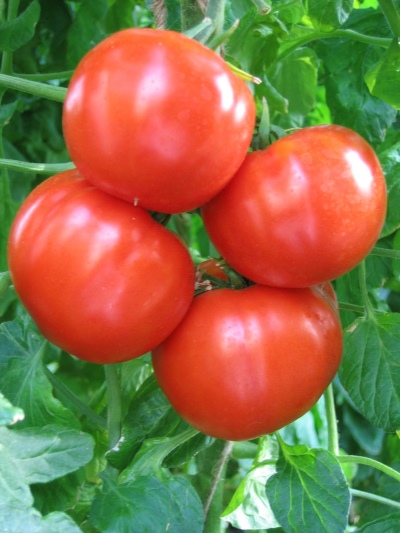
- Authors: Motov V. M. (OOO NPF "Agrosemtoms")
- Year of approval: 1999
- Category: hybrid
- Growth type: determinant
- Appointment: fresh consumption
- Ripening period: mid-early
- Ripening time, days: 105-110
- Growing conditions: for open ground, for film greenhouses, for closed ground
- Bush height, cm: 150-190
- Branchiness: medium
The Khlynovsky tomato can become a faithful companion even for sophisticated gardeners. Beginners, however, also have every chance to succeed. But first you need to understand the peculiarities of this culture.
Breeding history
The development of the plant was carried out in the well-known NPF "Agrosemtoms". VM Motov became the main breeder of the project. The crop has been allowed to be planted in ordinary vegetable gardens since 1999.
Description of the variety
From a botanical point of view, Khlynovsky is a classic hybrid, and not a variety in the true sense of the word. Determinant growth is typical for him. The height of tomatoes can be 1.5-1.9 m. With an average level of branching, an average foliage also develops. Dark green foliage has a slight perimeter corrugation.
The main qualities of the fruit
As usual with many varieties of tomatoes, Khlynovsky berries are also initially green. Another typical feature is the dark green area around the stalk. When the tomato is ripe, it takes on a red tint. The rest of the features are as follows:
flat-round geometry;
weight spread from 190 to 220 g;
development on simple inflorescences;
laying of the first inflorescence over 8 or 9 leaves;
the formation of the next inflorescences through 1 or 2 leaves.
Taste characteristics
The pulp of the berries of the Khlynovsky tomato is sweet. In terms of meatiness, this variety is at least as good as many attractive varieties. And it is also worth emphasizing the decent juiciness of the fruit.
Ripening and fruiting
The Khlynovsky tomato belongs to the mid-early group. Usually the harvest ripens in 105-110 days after the young greens come to the surface. You can shoot berries in July or August. It is necessary to check that the fruits have reached the stage of brown ripeness.
Yield
Such a tomato is highly productive. The official description indicates that its productivity can reach up to 12 kg per 1 sq. However, much depends on the weather conditions and on how diligent and prudent the farmers are.
The timing of planting seedlings and planting in the ground
It is necessary to sow seeds in containers from 20 to 30 March. The readiness of seedlings for transfer into open ground is visible already in April-May. The final decision must be made by the gardeners themselves. They need to monitor both the development of plants and the weather conditions.

Growing tomato seedlings is an extremely important process, because it largely depends on whether the gardener will be able to harvest at all. All aspects must be taken into account, from seedbed preparation to planting in the ground.
Landing scheme
The optimal cultivation regime is 700x400 mm. The highest possible concentration of bushes is 4 pieces per 1 m2. Some gardeners even deliberately limit themselves to 3 bushes in the same area. Low saturation of the earth is especially important if there is no solid experience yet.

Growing and care
It is strictly necessary to remove stepchildren who do not fit into the development scenario. The bushes are tied to a support and shaped. The claimed ability to sustainably tolerate damage:
late blight;
cladosporiosis;
tobacco mosaic;
verticillosis;
fusarium wilting.
Khlynovsky is also not badly affected by the effects of bad temperatures. Even their differences do not cause any particularly negative changes. However, you should not abuse such opportunities. Some gardeners plant this plant directly in free soil. But still, the seedling technique turns out to be much more effective.
It must be understood that the Khlynovsky tomato tolerates overexposure much worse than many other varieties. At every opportunity the weather provides, the plant should be planted. As soon as shoots appear, the seedlings are hardened at 14-16 degrees. This procedure must be carried out in the last 7 days before transshipment into open ground. A certain amount of superphosphate and wood ash is placed in the planting holes.
In greenhouses, bushes lead to 1 stem. In the south, in vegetable gardens, they are made out in 2 stems. Using 3 stems is important when grown outdoors in the north. The stepchildren break out as much as possible on a weekly basis.




A plant needs different micronutrients at each stage of growth. All fertilizers can be divided into two groups: mineral and organic. Folk remedies are often used: iodine, yeast, bird droppings, eggshells.
It is important to observe the rate and period of feeding. This also applies to folk remedies and organic fertilizers.


Review overview
The quality of this variety is very high. It is appreciated by many consumers and breeders. The plant is relatively unpretentious and suitable for those who wish to simplify planting care. With proper care, the likelihood of contracting disease is low. The height of the cultivated bushes is also optimal.

























































































